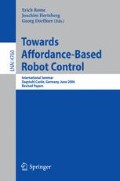Abstract
The concept of Ecology of Physically Embedded Intelligent Systems, or Peis-Ecology, combines insights from the fields of autonomous robotics and ambient intelligence to provide a new solution to building intelligent robotic systems in the service of people. The concept of Peis-Ecology also offers an interesting setting to study the applicability of Gibson’s notion of affordances to an ecology of robots. In this paper we introduce this concept, and discuss its potential and implications both from an application point of view and from an ecological (Gibsonian) point of view. We also discuss some new scientific challenges introduced by a Peis-Ecology, present our current steps toward its realization, and point at a few experimental results that show the viability of this concept.
Access this chapter
Tax calculation will be finalised at checkout
Purchases are for personal use only
Preview
Unable to display preview. Download preview PDF.
References
Arregui, D., Fernstrom, C., Pacull, F., Gilbert, J.: STITCH: Middleware for ubiquitous applications. In: Proc. of the Smart Object Conf., Grenoble, France (2003)
Barker, R.G.: Ecological psychology. Stanford University Press, Stanford, CA (1968)
Broxvall, M., Coradeschi, S., Loutfi, A., Saffiotti, A.: An ecological approach to odour recognition in intelligent environments. In: Proc. of the IEEE Int. Conf. on Robotics and Automation, Orlando, FL, pp. 2066–2071 (2006)
Broxvall, M., Gritti, M., Saffiotti, A., Seo, B.S., Cho, Y.J.: Peis ecology: Integrating robots into smart environments. In: Proc. of the IEEE Int. Conf. on Robotics and Automation, Orlando, FL, pp. 212–218 (2006)
Broxvall, M., Loutfi, A., Saffiotti, A.: Interacting with a robot ecology using task templates. In: Ro-Man. Proc. of the IEEE Int. Symp. on Robot and Human Interactive Communcation Jeju island, Korea (2007)
The JXTA community. The project JXTA web site, http://www.jxta.org
Coradeschi, S., Saffiotti, A.: An introduction to the anchoring problem. Robotics and Autonomous Systems 43(2-3), 85–96 (2003)
Coradeschi, S., Saffiotti, A.: Symbiotic robotic systems: Humans, robots, and smart environments. IEEE Intelligent Systems 21(3), 82–84 (2006)
Dressler, F.: Self-organization in autonomous sensor/actuator networks. In: Proc. of the 19th IEEE Int. Conf. on Architecture of Computing Systems (2006)
Duchon, A.P., Warren, W.H., Kaelbling, L.P.: Ecological robotics. Adaptive Behavior 6(3), 473–507 (1998)
Gibson, J.J.: An ecological approach to visual perception. Houghton Mifflin, Boston, MA (1979)
Gritti, M., Broxvall, M., Saffiotti, A.: Reactive self-configuration of an ecology of robots. In: Proc. of the ICRA Workshop on Networked Robot Systems, Rome, Italy (2007)
Heft, H.: Ecological Psychology in Context. Lawrence Erlbaum Associates, Mahwah (2001)
Kaminsky, A.: Infrastructure for distributed applications in ad hoc networks of small mobile wireless devices. Technical report, Rochester Institute of Technology, IT Lab, ( May 2001)
Kim, J.H., Kim, Y.D., Lee, K.H.: The third generation of robotics: Ubiquitous robot. In: Proc. of the 2nd Int. Conf. on Autonomous Robots and Agents, Palmerston North, New Zealand (2004)
LeBlanc, K., Saffiotti, A.: Issues of perceptual anchoring in ubiquitous robotic systems. In: Proc. of the ICRA Workshop on Omniscent Space, Rome, Italy (2007)
Lee, J.H., Hashimoto, H.: Intelligent space – concept and contents. Advanced Robotics 16(3), 265–280 (2002)
Lemaire, O., Ohba, K., Hirai, S.: Dynamic integration of ubiquitous robotic systems using ontologies and the rt middleware. In: Proc. of the 3rd Int. Conf. on Ubiquitous Robots and Ambient Intelligence, Seoul, Korea (2006)
Lundh, R., Karlsson, L., Saffiotti, A.: Plan-based configuration of an ecology of robots. In: Proc. of the IEEE Int. Conf. on Robotics and Automation, Rome, Italy, pp. 64–70 (2007)
Margulis, L., Sagan, D.: Microcosmos. Summit Books, New York (1986)
McGrenere, J., Ho, W.: Affordances: Clarifying and evolving a concept. In: Proc. of the Graphcis Interface Conf., Toronto, pp. 179–186 (2000)
Michaels, C.F: Affordances: Four points of debate. Ecological Psychology 15(2), 135–148 (2003)
Norman, D.: The Design of Everyday Things. Basic Books (1988)
Network Robot Forum. www.scat.or.jp/nrf/English/
The PEIS ecology project. Official web site, www.aass.oru.se/~peis/
Rao, J., Su, X.: A survey of automated web service composition methods. In: Proc. of the 1st Int. Workshop on Semantic Web Services and Web Process Composition, San Diego, California, USA (2004)
Raubal, M., Moratz, R.: A functional model for affordance-based agents. In: Rome, E., Doherty, P., Dorffner, G., Hertzberg, J. (eds.) Towards Affordance-Based Robot Control. LNCS, vol. 4760, pp. 106–121. Springer, Heidelberg (2007)
Saffiotti, A., Broxvall, M.: PEIS ecologies: Ambient intelligence meets autonomous robotics. In: sOc-EUSAI. Proc. of the Int. Conf. on Smart Objects and Ambient Intelligence, Grenoble, France, pp. 275–280 (2005)
Sgorbissa, A., Zaccaria, R.: The artificial ecosystem: a distributed approach to service robotics. In: Proc. of the IEEE Int. Conf. on Robotics and Automation, pp. 3531–3536 (2004)
Siegemund, F.: A context-aware communication platform for smart objects. In: Proc. of the Int. Conf. on Pervasive Computing (2004)
Tesauro, G., Chess, D.M., Walsh, W.E., Das, R., Segal, A., Whalley, I., Kephart, J.O., White, S.R.: A multi-agent systems approach to autonomic computing. In: Proc. of the Int. Conf. on Autonomous Agents and Multiagent Systems, pp. 464–471 (2004)
Author information
Authors and Affiliations
Editor information
Rights and permissions
Copyright information
© 2008 Springer-Verlag Berlin Heidelberg
About this paper
Cite this paper
Saffiotti, A., Broxvall, M. (2008). Affordances in an Ecology of Physically Embedded Intelligent Systems. In: Rome, E., Hertzberg, J., Dorffner, G. (eds) Towards Affordance-Based Robot Control. Lecture Notes in Computer Science(), vol 4760. Springer, Berlin, Heidelberg. https://doi.org/10.1007/978-3-540-77915-5_8
Download citation
DOI: https://doi.org/10.1007/978-3-540-77915-5_8
Publisher Name: Springer, Berlin, Heidelberg
Print ISBN: 978-3-540-77914-8
Online ISBN: 978-3-540-77915-5
eBook Packages: Computer ScienceComputer Science (R0)

